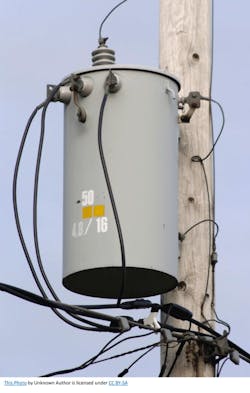It won’t have an immediate transformative effect on troublesome shortages, but a new U.S. Department of Energy (DOE) ruling brings more clarity to solving the long-term puzzle of future transformer design, production and supply.
On April 4, the DOE issued its long-debated final rule on distribution transformer energy efficiency standards, crafting a sort of middle ground between staunch advocates of ramping up supply of ultra-high efficient units and those prioritizing more assured and affordable domestic production. The debate is a critical one because demand for new transformers is projected to explode in coming years, sharpening the stakes for both stances.
The rule mandates that more new transformers must be built using amorphous metal (AM) cores, which produce units with significantly higher energy efficiency than those that utilize grain-oriented electrical steel (GOES) cores that are commonplace. By 2029, up to 25% of all new distribution transformers (distinct from utility-scale, large-power transformers) must incorporate AM cores, which minimize energy loss.
DOE revamped those targets in a big way after critics piled on. Its preliminary rule, issued in January 2023, called for a 90% AM target and a two-year time frame for compliance. Opponents, ranging from utilities, home builders and contractors to steel producers, transformer manufacturers, and members of Congress, argued the DOE plan would exacerbate transformer shortages that ramped up during the COVID-19 pandemic and persist, slow the pace of grid modernization and cement reliance on foreign suppliers and concurrent decimation of the domestic industry. Requiring more AM steel, they said, would chain much future transformer production to a single domestic supplier, a Japan-owned firm in South Carolina that, critically, imports AM steel from China. Meanwhile, domestic transformer production would have withered along with production at the primary GOES supplier, two U.S. plants run by AK Steel.
Those domestic supply concerns — along with worries about transformer shortages and the potential scope of the then pending DOE rule — are reflected in Congressional legislation introduced in January 2024. As DOE was drafting its final rule, lawmakers in the House and Senate introduced bills that would dramatically slow transition to AM cores. The lead bill, The Distribution Transformer Efficiency & Supply Chain Reliability Act of 2024, calls for broadly limiting DOE latitude on writing transformer efficiency guidelines and a 10-year timeline, at best, for implementation of new AM requirements. It has not yet moved out of committees.
The final rule, while changed from the preliminary draft that drew heavy fire, may not be sitting well with critics. A vocal one, National Electrical Manufacturers Association, quickly responded to the final rule announcement by saying it warranted scrutiny. Acknowledging meaningful revisions, NEMA signaled that the rule is likely still too onerous and may only be cured by passage of superseding legislation. In a prepared statement, NEMA President and CEO Debra Phillips said it was reviewing the rule “through the multiple lenses of grid reliability, supply chain resiliency, and energy efficiency.” At first blush, she said, it looks to fall short of addressing a primary need.
“Our nation’s ability to meet growing demand for electricity relies on a readily available supply of distribution transformers,” it reads. “We remain concerned that the rulemaking may exacerbate supply chain challenges and long lead times for these critical grid components.”
Future energy efficiency considerations aside, insufficient transformer supply has taken a toll on utilities, developers, contractors and engineering and design firms. In October 2022, four contractor trade groups, including Independent Electrical Contractors, laid out the impact of transformer shortages in a letter to the administration. Citing falling imports and the mounting impact of shortages on construction projects, notably housing, it called on the administration to convene a summit with affected stakeholders. The problem may have only worsened since then. American Public Power Association said in January that lead times for utility purchases of new distribution transformers have grown from three months in 2018 to over two years today.
Yet utilities and developers they serve must still move ahead on system upgrades that often call for new transformers. That calls for design firms and contractors to factor likely delays into their planning, moving projects ahead and keeping them on schedule as much as possible while backing in projected unit delivery timelines. Additionally, they’re having to begin accounting for the design and installation implications of a steady influx of a new generation of higher-efficiency, AM-core transformers.
Electrical designers at Core States Group, Duluth, Ga., are navigating the supply challenge by trying to minimize the potential impact of shortages on clients with transformer needs. Chris Sacco, P.E., director of electrical engineering, approaches the challenge by prioritizing a careful needs analysis. There may be cases in site renovations, he says, where his engineering team will review the existing conditions of a site and create an action plan to analyze if transformer replacement is required. In other cases, a more custom transformer product that may have particularly long lead times may be ruled out in favor of one that’s more readily available and will still meet the owner’s demands and proposed functionality.
“The big challenge from a design standpoint is lead times, which can be significant,” he says. “At Core States Group, we strive to standardize and create efficient designs that utilize consistent equipment. This will allow the owner to have knowledge of the necessary equipment and place orders at an earlier phase in the process in order to minimize delays in project schedules caused by lead times.”
Transformer shortages are proving burdensome for Five-Star Electric, an Ozone Park, N.Y.-based electrical contractor. At times, certain projects are often thrown off schedule by abnormally long lead times that can be hard to nail down, resulting in last-minute scrambles to install them upon arrival, says president and CEO, Russ Lancey.
“We’re often in the position of having to run an audible to get them installed as quickly as possible,” he says. “Clients are aware of the issues and these are excusable delays, but we’re not typically compensated for jobs being pushed back, which puts a hardship on us.”
Knowing the situation, he says, some clients will adjust their design specifications or allow subsitutions to accommodate transformers that may be easier to source, while others might pay up to get an order expedited. But the typical scenario involves pushing to to get the products as quickly as possible and improvising in the field to prevent any project delays.
“Supply chain issues for transformers and other specialty products have stabilized some but I thought we’d be in a better place by now,” he says. “Construction spending is only rising so it’s going to continue to be a challenge.”
Some measure of uncertainty that companies like Five-Star are navigating has been taken out of the transformer supply and demand picture of the future with the recent DOE action. For now, though, electrical design and installation firms have no choice but to tough it out, realizing that they’re at the mercy of the vagaries of a market mired in what may be a long and perhaps challenging transition.




